Compare the Art of the Minoan and Mycenaean Civilizations
The Bronze Age Aegean in the eastern Mediterranean encompassed several powerful entities: the Minoans on Crete; the Mycenaeans on mainland Greece, and the Cypriots on Cyprus. These cultures are oftentimes examined separately, and thus the aplenty cross-cultural manual betwixt them is overlooked. Focussing on the Minoans and Mycenaeans, although they are oft perceived as one following after the other, there were a few hundred years in which the dominance in the Aegean shifted from the Minoans to the Mycenaeans. The waning of Minoan influence and waxing of Mycenaean say-so has been observed from the archaeological evidence, and the close connectedness between the two cultures is represented in similarities in the architecture of the palatial complexes, burial practices, and the transmission of iconography and goods from Crete to the mainland.
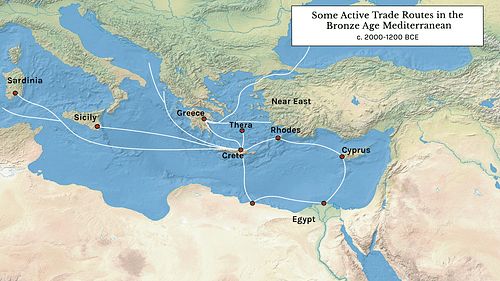
Some Active Trade Routes in the Statuary Age Mediterranean
Merchandise
The act of trade involves the transference of goods and people, which in turn causes exposure of beliefs and practices between different cultures. Artefacts uncovered at palatial sites and burials of both the Minoans and Mycenaeans brandish their extensive connections via trade networks with other civilisations of the ancient world, including Arab republic of egypt, Cyprus and the Virtually East. The Minoans and Mycenaeans had frequent contact, and the elite at Mycenae used the shaft grave burials every bit a means of expressing buying over foreign and exotic goods. It is primarily through the burial goods of the Mycenaean elite that a pattern for the preference of Minoan adroitness and iconography has been recognised.
The Minoans may accept been working as intermediaries between the Mycenaeans & other cultures, such as Egypt.
Archaeological finds from Mycenaean sites such as Mycenae and Pylos indicate that the Minoans may take been working as intermediaries between the Mycenaeans and other cultures, such every bit Egypt, in their well-established trade networks. This theory has been addressed by Burns who commented: "not merely was Minoan Crete a major source for prestige items in the Shaft Graves, merely many of the materials and items imported from the eastern Mediterranean seem to have come up through Minoan intermediaries" (76). This theory is corroborated through artefacts such as an ostrich egg, known from Egyptian craftsmen but plant in a Mycenaean burial with Minoan embellishments, suggesting Minoan interference earlier its interment with a Mycenaean aristocracy.
The agreement of Bronze Age trade and active networks is informed largely by multiple shipwrecks which have been excavated past underwater archaeologists. Due to their capsizing, the organic materials onboard the ships accept preserved meliorate in water than if they had been buried. The well-known Uluburun shipwreck capsized off the southern coast of Anatolia and dates to either the late 14th century of the early on 13th century BCE. This shipwreck carried artefacts and raw materials from Egypt, Cyprus, the Greek Mainland, Crete, and the Levant; information technology was the pottery on board which aided in the dating of the send.
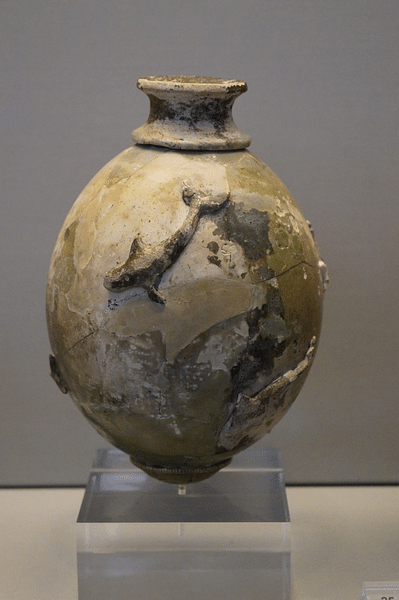
Ostrich Egg Rhyton
Art & Craftsmanship
Since the Minoans are the older culture, it makes sense that they had influenced the Mycenaeans more than the other mode around. The Minoans are known for their intricate, high-quality pottery and craftsmanship, and the numerous burial appurtenances of Cretan provenance and Minoan influence on mainland Greece suggests there was a high demand for it in the aristocracy Mycenaean society. The Mycenaeans non but expressed their preference for Minoan craftsmanship but incorporated common Minoan iconographical motifs such as the octopus from the iconic Marine Ware into their own, more than structured and geometric-mode art. The Minoans were known for their free-flowing artistic decoration and showed a preference for marine and plant life.
The best example for the contrast of artistic styles of the Minoans and Mycenaeans is displayed through the two gold cups found at the Mycenaean Vaphio tomb. This LH Ii tholos tomb presented two gilded cups; known every bit the Vaphio cups. At outset glance they seem identical, however, with greater assay, they non merely convey two entirely different scenes simply also represent different artful styles, which suggests two dissimilar craftsmen. With ane loving cup being named the quiet or calm cup and the other the violent cup, it seems as though the similarity in the bull scenes may have been planned by the same person but executed by different people; the calm bull scene by a Minoan craftsman and the violent balderdash scene by a Mycenaean. The calm bull scene is well-executed and freeform, with the handles placed on peak of the design, seemingly as an afterthought. This conforms to the Minoan preference for free-flowing scenes and their superior craftsmanship.
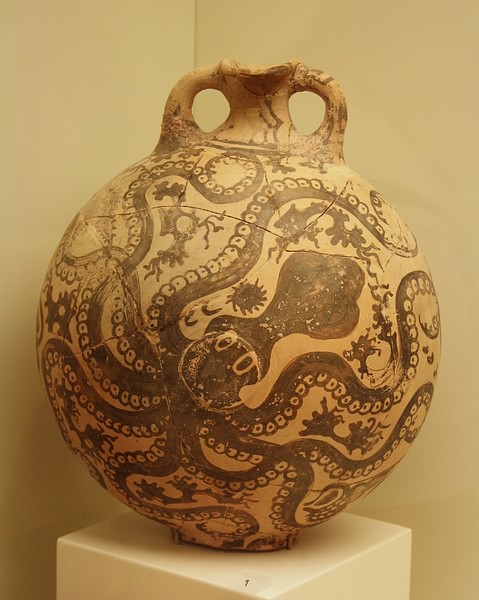
Minoan Vase in Marine Way
Often the quality of artefacts uncovered in Mycenaean burials suggests they were made by Minoans for a mainland audition. This theory is corroborated by the inlaid daggers frequently depicting hunting scenes just fabricated with such intricacy that they are believed to exist from the easily of Minoan artisans. Recently, the discovery of the Griffin Warrior tomb at Pylos by Jack Davis and Sharon Stocker has added hundreds of aristocracy burying goods to the corpus plant at Pylos. One of the nearly detailed warrior scenes from the Aegean world was institute in this burial, the Gainsay Agate, and is believed to have been manufactured on Late Minoan Crete for a mainland audience.
Compages
Mycenaean city centres were centralised spaces for the redistribution of goods & had areas for the storage of oils and grains, & rooms for specific crafts.
The palace centres on Crete were not palaces in a modern sense but seem to have been the centre of authoritative business, religious activity, and a centralised space for commerce and trade. The palaces were grand structures, with Knossos existence the largest of the main sites and the simply i that kept its grandeur later on the widespread destruction c. 1700 BCE. One striking feature on Crete is the lack of fortifications effectually the deluxe centres, which has encouraged speculation that the Minoans were fairly peaceful and may accept non feared attack from outside forces. Since we cannot decipher the linguistic communication of the Minoans - Linear A - what tin can exist inferred of the usage of the centres rests entirely on the archaeological record.
The Mycenaean palatial centres are similar but smaller than Minoan centres and were almost all heavily fortified, except for Pylos. The ruins of the palace of Nestor provide evidence of small fortifications a fair distance from the city centre, equally opposed to other cities similar Mycenae and Tiryns. The enormous size of the fortification walls led the earlier Greeks to call them 'Cyclopean walls' since they could have only been built by the race of one-eyed giants, the cyclops. We know from the extant Linear B archives, primarily from the archives establish at Pylos and Knossos, that the Mycenaean city centres were, similar the Cretan centres, centralised spaces for the redistribution of appurtenances and had areas for the storage of oils and grains, and rooms for specific crafts. We also know that these Mycenaean centres were ruled by a wanax, which was similar a lord, and their second-in-command was a lawagetas, which was like a governor.
Burials
The Minoans cached their elite in pithoi (singular: pithos), or large burial jars, a practice which has been uncovered in the Grave Circle at Pylos, although the discovery of multiple bodies in one burying jar exhibits the Mycenaeans' adoption of and subsequent deviation from the Minoan burial practice. Additionally, the Minoans constructed tholos or beehive tombs, which was a mode of burial also used by the Mycenaeans. The tholos tomb is a construction created by a process known as corbelling which constitutes layers of bricks or stones which grow increasingly smaller to form a tomb with a beehive resemblance. The earliest tholos tomb on the mainland is believed to be Tholos Iv at Pylos, even so the most iconic is the Treasury of Atreus, besides known as the Tomb of Agamemnon, built c. 1250 BCE at Mycenae. Two previously undiscovered tholos tombs accept recently been uncovered next to Tholos IV at Pylos; although they have not yet been dated, they accept been named Tholos VI and Tholos VII.
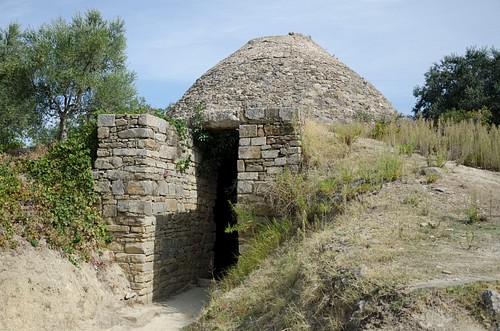
Tholos IV at Pylos
The burial appurtenances from the Mycenae shaft graves (where the iconic gold death masks were discovered) express a close human relationship with the Minoans. As Higgins has noted; "many of the treasures from these two Grave-Circles are of Cretan origin, and nearly all show Cretan influence," an occurrence which has been identified at Pylos, especially with the discovery of the Griffin Warrior burial (76). The majority of artefacts published from the rich burial of the Griffin Warrior expresses a preference for Minoan religious iconography and Minoan craftsmanship. The Shaft Grave period of the Mycenaean civilization was during the formative stages of the culture. The exotic Cretan artefacts "were recontextualized in graves like that of the Griffin Warrior, as foundations for the Mycenaean civilisation were laid," influencing their decorative preferences and cultural practices (Davis, 2016, 652).
Organized religion
Although the intricacies of Minoan religion are a mystery to us, facets of Minoan religious practices take survived through art. From frescoes, signet rings, seal stones and deposits, nosotros know they participated in libations, processions, feasts, and even the ritual event of balderdash-leaping. The Minoans had many prominent religious symbols which have been found in religious sanctuaries, burials, and at palatial sites: the horns of consecration, the sacral knot, and the double axe.
There are several depictions of priestesses and women performing religious rituals, and numerous ivory carvings of a deity who has been given the name of The Snake Goddess past modern-day scholars; her original name is unknown. The presence of a main female deity and its transmission to the mainland has been noted by Marinatos: "the dominant goddess of the Minoan pantheon was a female one, and… her symbol was the double axe. Representations of this goddess grow in murals, rings, and seals even on objects found on the mainland of Hellenic republic" (249).
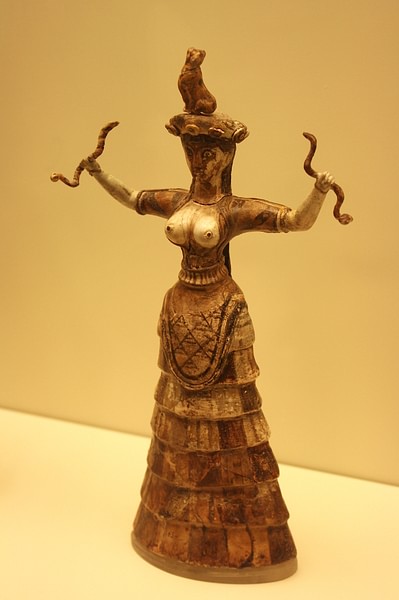
Minoan Snake Goddess, Knossos.
Frescoes show the utilize of rhytons which were libation vessels used for ritual purposes and were often highly ornamented. The Minoans took part in religious activities in sanctuaries which were either on a high mountain summit (no further than 3 hours walk from settlements) or in caves, and information technology seems these subterranean rituals required the presence of stalactites and stalagmites to exist effective, only what the meaning of these was is unknown.
Not much is known nigh the religion of the Mycenaeans, other than what has been causeless from preserved art and the archaeological record. This is due to the Linear B archives being used exclusively for economic and authoritative records. There is testify of communal feasting, animal sacrifice, libations and food offerings, and although they seem to take adopted some religious symbols from the Minoans, such as the double axe, information technology is not clear whether this symbol meant the aforementioned to the Mycenaeans as it did on Crete. Nosotros do, however, accept Linear B tablets which mention some of the same gods that were venerated by the Classical Greeks who came afterward them, including Poseidon, Zeus, Artemis, and Hermes.
Conclusion
The Minoan and Mycenaean civilizations were separate cultures with distinctive features and differences, but they did not exist entirely separately. The archaeological record has provided us with a great bargain of data about their interconnectedness, transmission of ideas and goods, and shifts in political and trade dominance in the Mediterranean. The influence on the Mycenaeans past the Minoans on Crete has been expressed through their similar yet smaller palatial centres, their burying practices, possession of goods and adoption of common Minoan symbols.
This article has been reviewed for accuracy, reliability and adherence to academic standards prior to publication.
schumacherdides1938.blogspot.com
Source: https://www.worldhistory.org/article/1610/the-minoans--mycenaeans-comparison-of-two-bronze-a/
0 Response to "Compare the Art of the Minoan and Mycenaean Civilizations"
Post a Comment